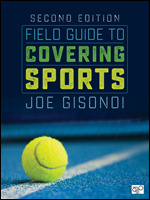Field Guide to Covering Sports
Second Edition
- Joe Gisondi - Eastern Illinois University, USA
Other Titles in:
Journalism
Journalism
July 2017 | 416 pages | CQ Press
How best to turn yourself from sports fan to professional sports journalist? Quickly moving beyond general guidance about sports writing, Joe Gisondi focuses on the nitty-gritty, with hands-on, practical advice on covering 20 specific sports. From auto racing to wrestling, you’ll find tips on the seemingly straightforward—where to stand on the sideline and how to identify a key player—along with the more specialized—figuring out shot selection in lacrosse and understanding a coxswain’s call for a harder stroke in rowing. The new edition adds a new section on sports reporting across multimedia platforms with new chapters on social media, mobile media, visual storytelling, writing for television, and writing for radio, along with a new chapter on sabermetrics. Fully revised with new examples and updated information to prepare you for just about any game, match, meet, race, regatta or tournament you’re likely to cover, Field Guide to Covering Sports, Second Edition is the ideal go-to resource to have on hand as you master the beat.
Foreword
Preface
Acknowledgments
PART I. GETTING STARTED
1. From Sports Fan to Sports Reporter
2. Writing Game Stories
3. Getting the Most Out of an Interview
4. Developing and Writing Features
5. Developing Sports Columns
6. Blogging: Finding a Unique Perspective
7. Using Advanced Statistical Metrics
PART II. MULTIMEDIA
8. Social Media: Using Twitter as a Reporting Tool
9. Writing for Mobile Devices
10. Visual Storytelling
11. Broadcasting Games on Radio
12. Writing for TV
PART III. COVERING A BEAT
Auto Racing
Baseball
Basketball
Bowling
Cross Country
Field Hockey
Football
Golf
Ice Hockey
Lacrosse
Rowing
Rugby
Soccer
Softball
Swimming & Diving
Tennis
Track and Field
Triathalons
Volleyball
Wrestling
PART IV. EXPLORING FURTHER
Primer A: Ethics: Sports Writers Can’t Act Like Fans
Primer B: Covering Fantasy Sports
Primer C: Covering a College Beat
Primer D: High School Sports
Primer E: Avoiding Clichés
Appendix: Assignment Desk
AP Style Sports Quizzes
Notes
Index
About the Author
No supplemental materials available (i.e. quizzes)
College of Media, Comm & Info, University Of Colorado-Boulder
December 16, 2019

